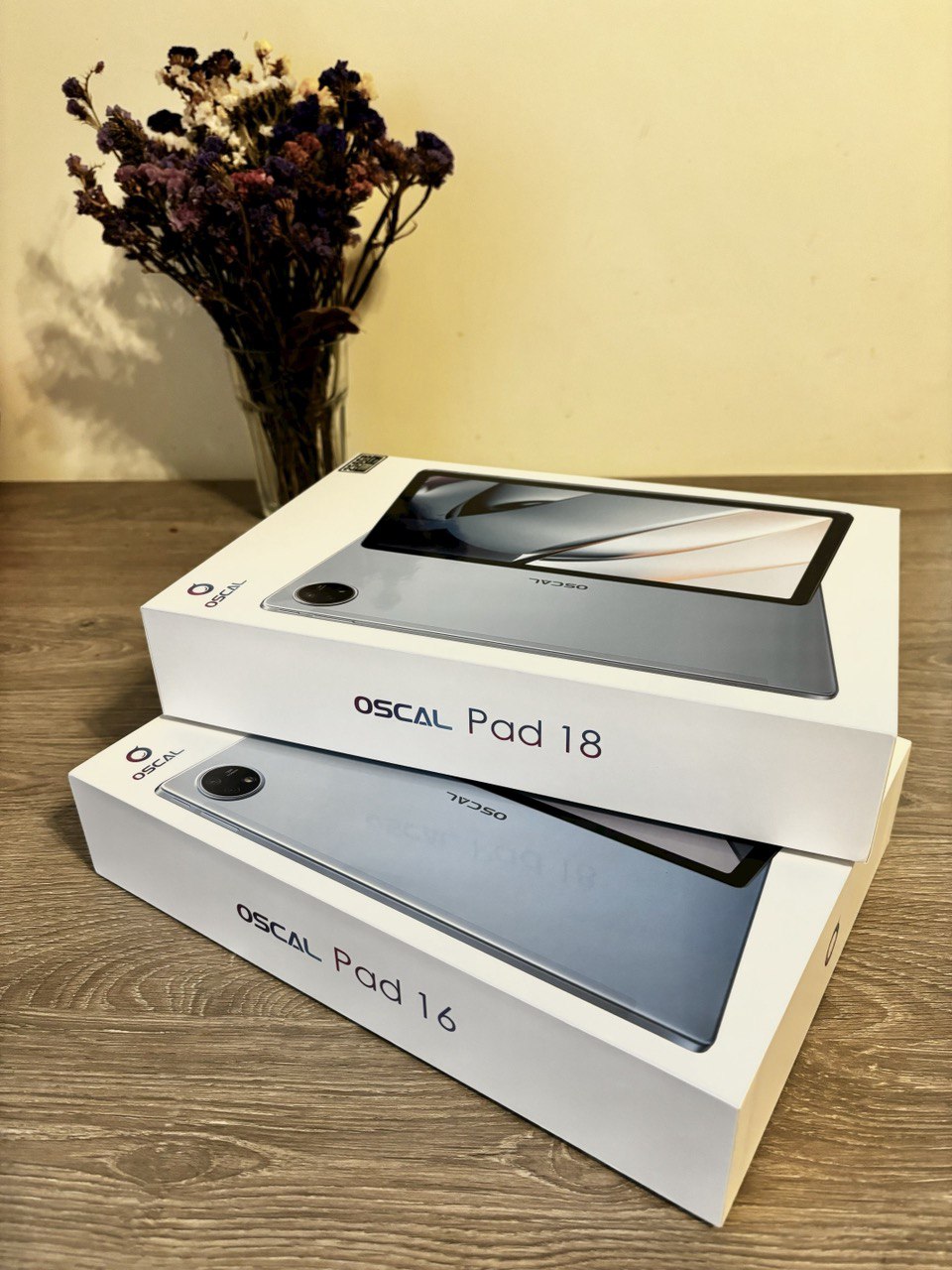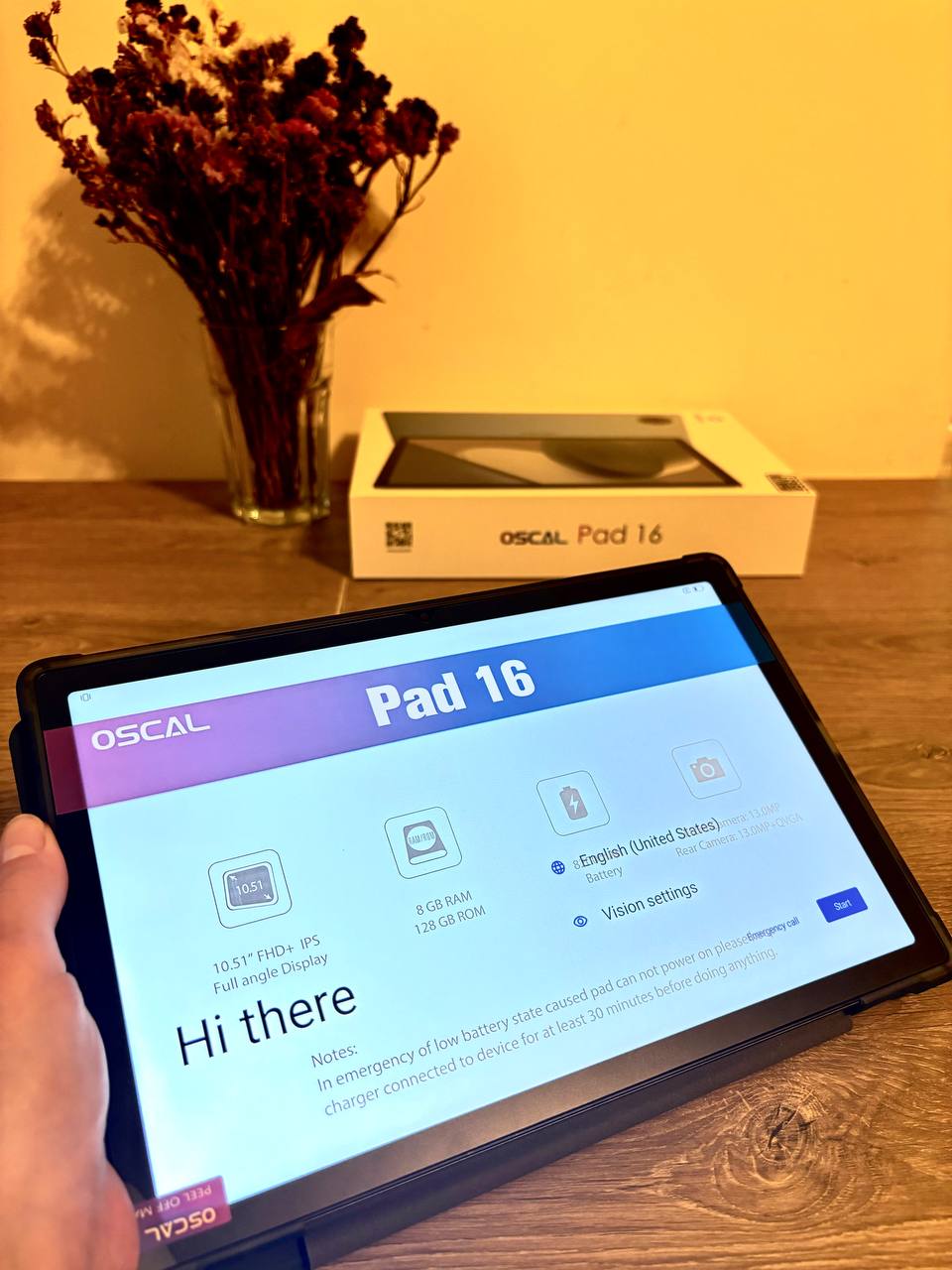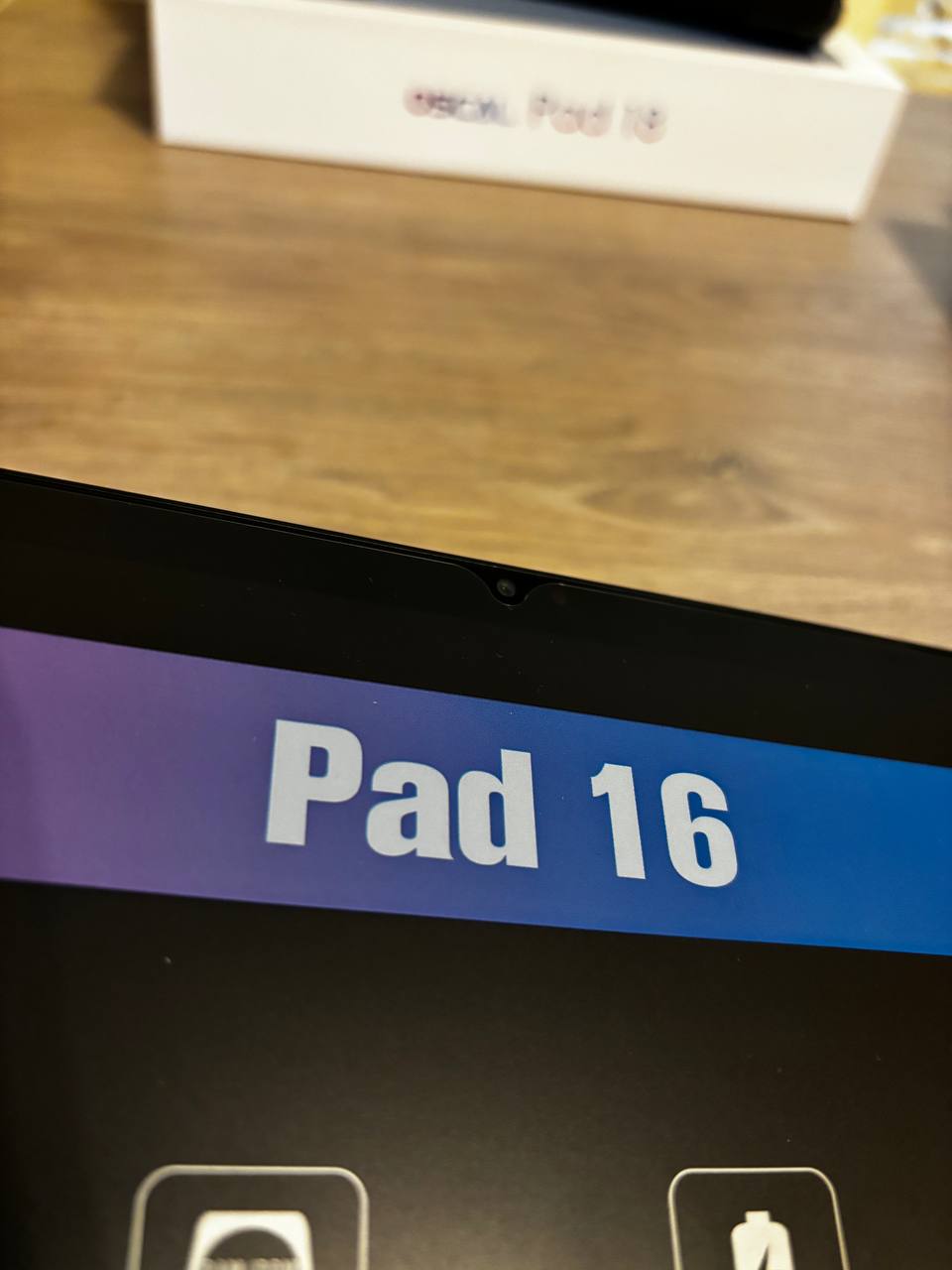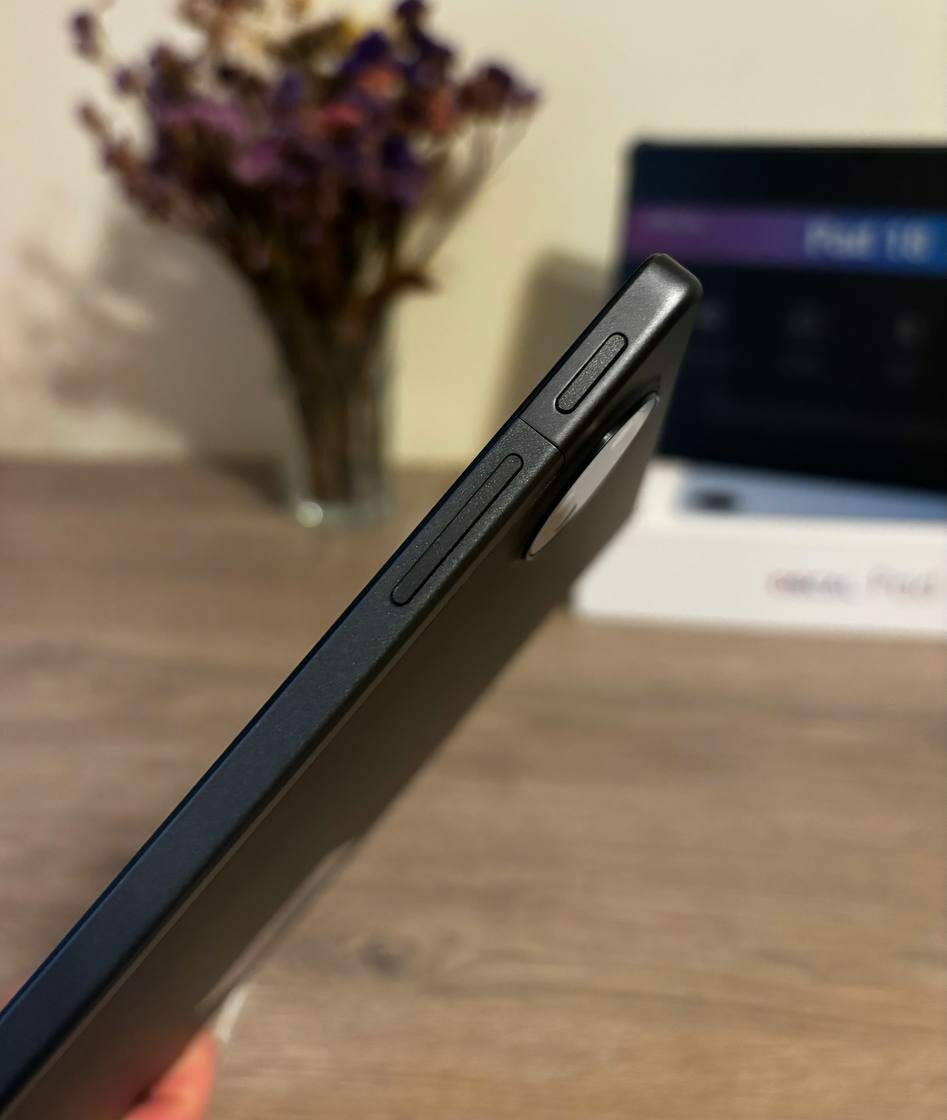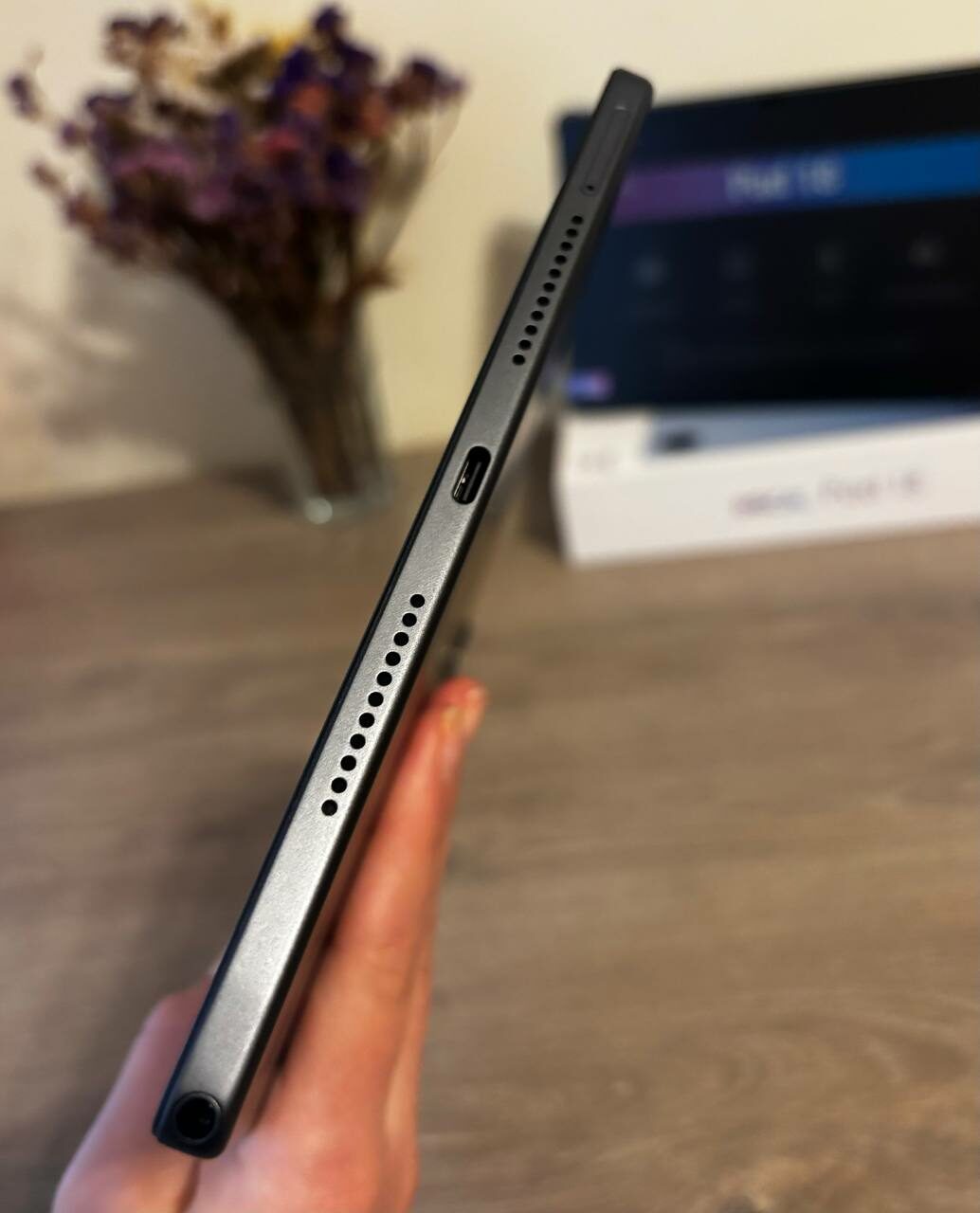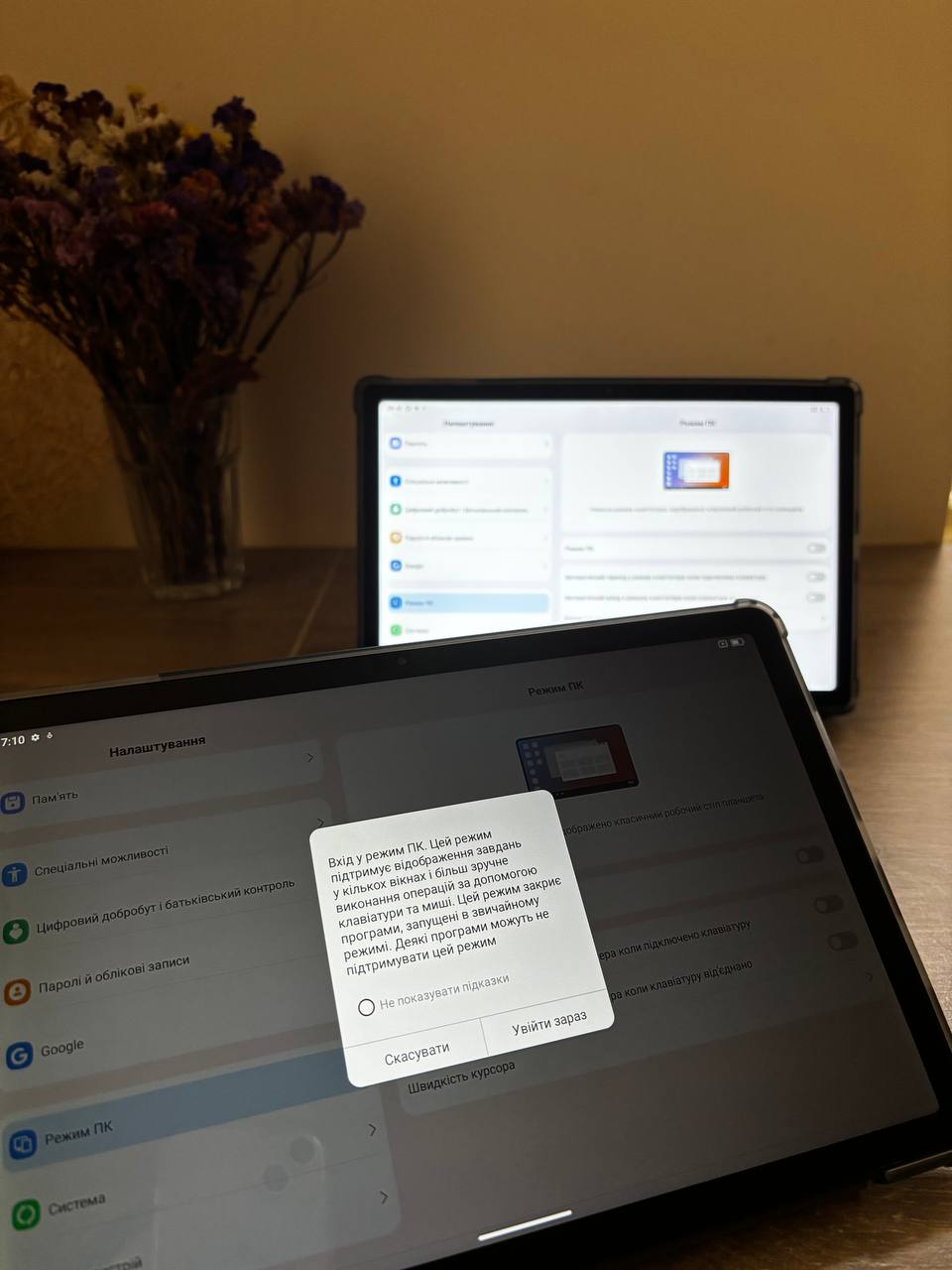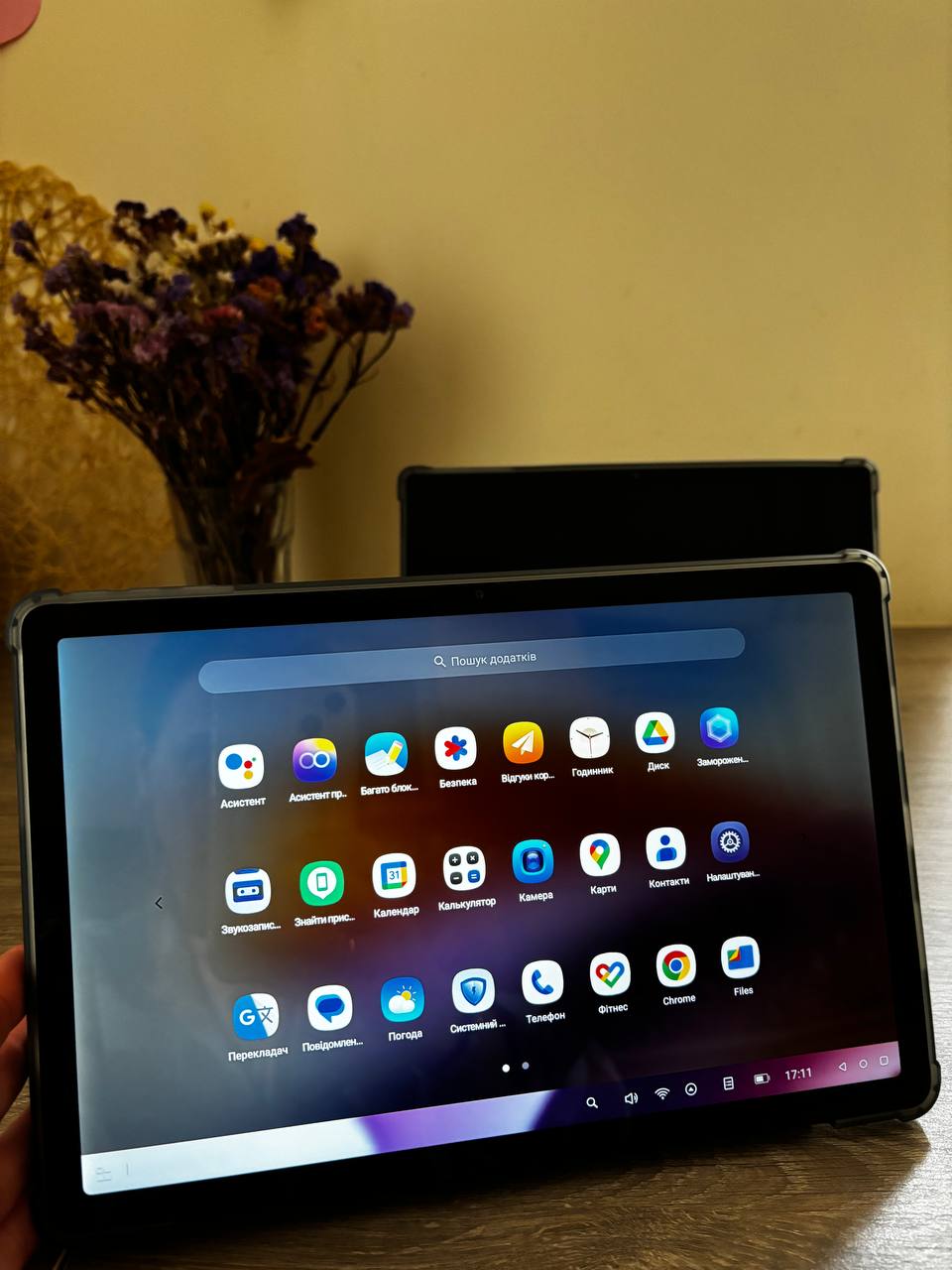Rumors about the disappearance of tablets from the electronics market have been circulating for years. However, the popularity of online work and learning formats has propelled the industry to a new level of demand in recent years. As a result, manufacturers continue to release new models tailored to various needs and budgets. A tablet can serve both entertainment and be a full-fledged work tool. Today, let’s talk about two of them right away – Oscal Pad 16 and Oscal Pad 18.
Before moving on to the direct review, I want to say a few words about the Oscal brand. The brand’s philosophy is to provide users with stylish, reliable, and powerful devices at a reasonable price.
Read also: 1stPlayer Moto-GT 1675 Computer Desk Review: Large, Versatile, Motorized
Technical specifications of Oscal Pad 16 and Oscal Pad 18
Oscal Pad 16
- Display: IPS, 10.5″, 1920×1200 pixels
- Body materials: metal, plastic
- Operating system: Android 13 with Doke OS_P 3.0 shell
- Chipset: Unisoc T606
- Graphics: Mali-G57
- RAM: 8 GB LPDDR4x + support for software memory expansion
- ROM: 256 GB
- Memory card support: up to 1 TB
- Main camera: 13 megapixels
- Front camera: 13 megapixels
- Bluetooth 5.0 (SBC codec)
- Wireless networks: Wi-Fi 4(n) + 5(ac), 2.4 GHz + 5 GHz, LTENavigation: GLONASS, GPS, A-GPS, Galileo, BeiDou
- Charging connector: Type-C (USB 2.0) with support for USB-OTG
- Battery: 8200 mAh with 18W charging support
- Dimensions: 246.55×160.75×7.40 mm
- Weight: 515 g
Oscal Pad 18
- Display: 11″ FHD + IPS 1200×1920
- Case materials: metal, plastic
- Operating system: Android 13 with Doke OS_P 3.0 shell
- Chipset: Unisoc Tiger T616
- Graphics: Mali-G57 MP1
- RAM: 8 GB
- ROM: 256 GB
- Memory card support: up to 1 TB
- Main camera: 13MP + 2MP
- Front camera: 8 megapixels
- Bluetooth 5.0
- Wireless networks: Wi-Fi 5 (802.11ac), LTE
- Navigation: GPS, Galileo, BDS
- Charging connector: Type-C (USB 2.0) with support for USB-OTG
- Battery: 8800 mAh with 18W charging support
- Dimensions: 256.75×168.30×7.40 mm
- Weight: 490 g
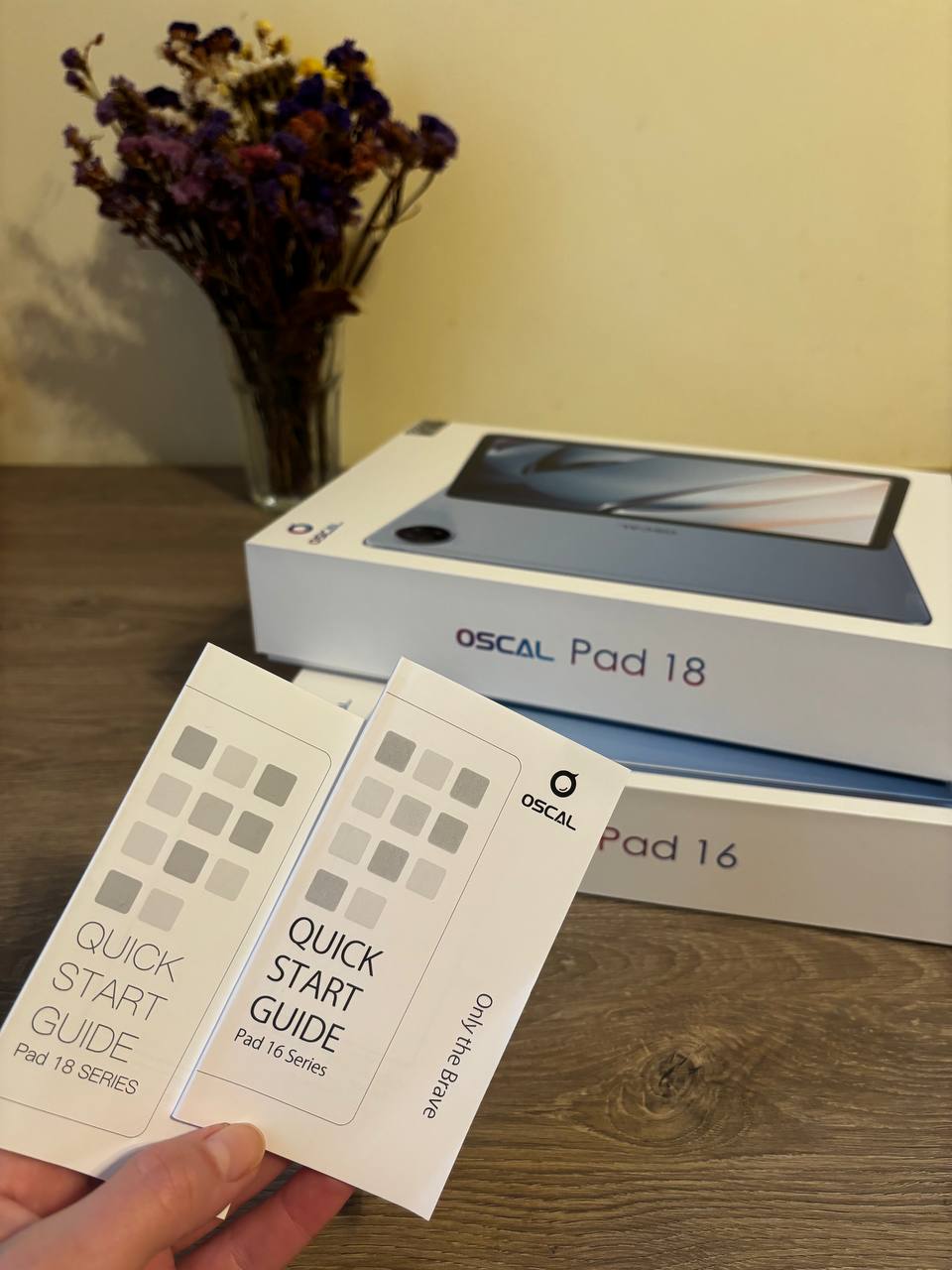
As we can see, the tablets have quite a few similarities. However, when choosing between the Oscal Pad 16 and Pad 18, the user should pay attention to their differences. Among them is weight – the Pad 16 weighs 515g, compared to 490g for the Pad 18. At first glance, the difference in weight may seem small, but not for this type of device. The fact that the Oscal Pad 18 is lighter than its “older brother” is immediately noticeable. Additionally, the first tablet has a smaller screen diagonal (10.5″ in Oscal Pad 16, 11″ in Oscal Pad 18, respectively) and battery capacity (Pad 16 has a capacity of 8200 mAh, while Pad 18 has 8800 mAh). It’s also worth noting the differences in chipsets and graphics.
Read also: ASUS ZenScreen MB16AHG Portable Monitor Review
Positioning and price
Both tablets belong to the budget segment. Although the Oscal Pad 18 is considered newer than the Pad 16, it will cost only slightly more. The price of the Oscal Pad 16 on the manufacturer’s official website is $192, while the Oscal Pad 18 is priced at $203. As we can see, the difference is minimal.
Package contents
I wasn’t surprised by the fact that the configuration of the Oscal Pad 16 and Oscal Pad 18 tablets is the same. The manufacturer focuses on functionality, but also pays a lot of attention to the configuration.
So, the tablets are supplied in sturdy glossy cardboard boxes. On the front side, there are images of the tablets themselves and the brand logo. On the side of the cover, there is a QR code linking to the Oscal store. On the back of the box, there are technical specifications and manufacturer details. Overall, everything is standard.
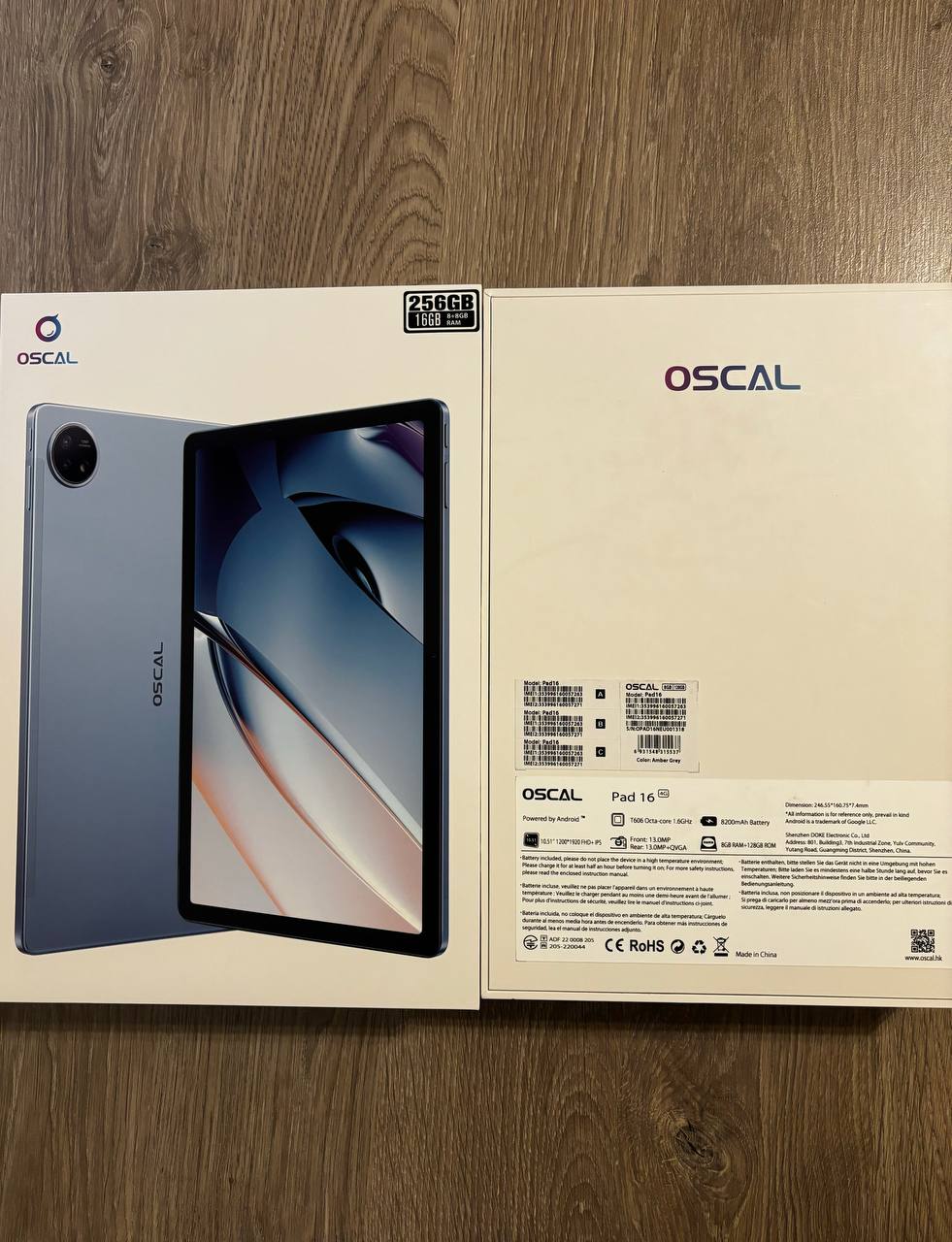
Inside the boxes, we see the tablet itself, a power adapter with a single USB port with a power of 18 watts, a USB-A to Type-C cable, a stylus, a SIM card tray removal tool, a protective glass, a case, and documentation. All the components of the kit are placed inside the box on a plastic tray, which provides additional protection during transportation.
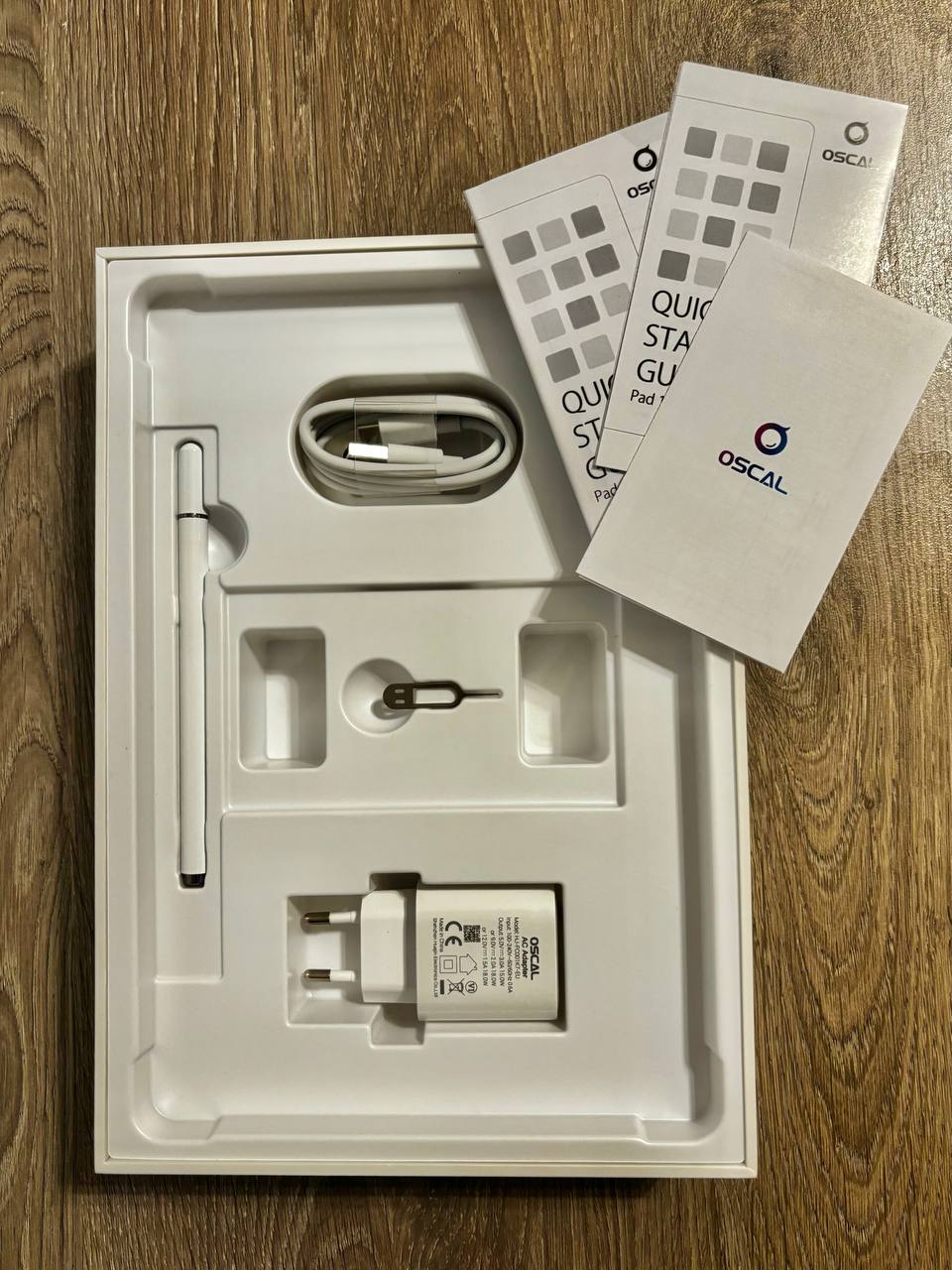
The case is magnificent, with high-quality soft-touch coating, pleasant to the touch, and of a practical black color, giving the impression that it will last long. Therefore, the question of tablet transportation safety is closed.
Additionally, the case can be used as a stand – its front side folds, allowing the tablet to stand both horizontally and vertically. Very convenient! Closing the case leads to the display being locked, and when opened, the screen turns on.
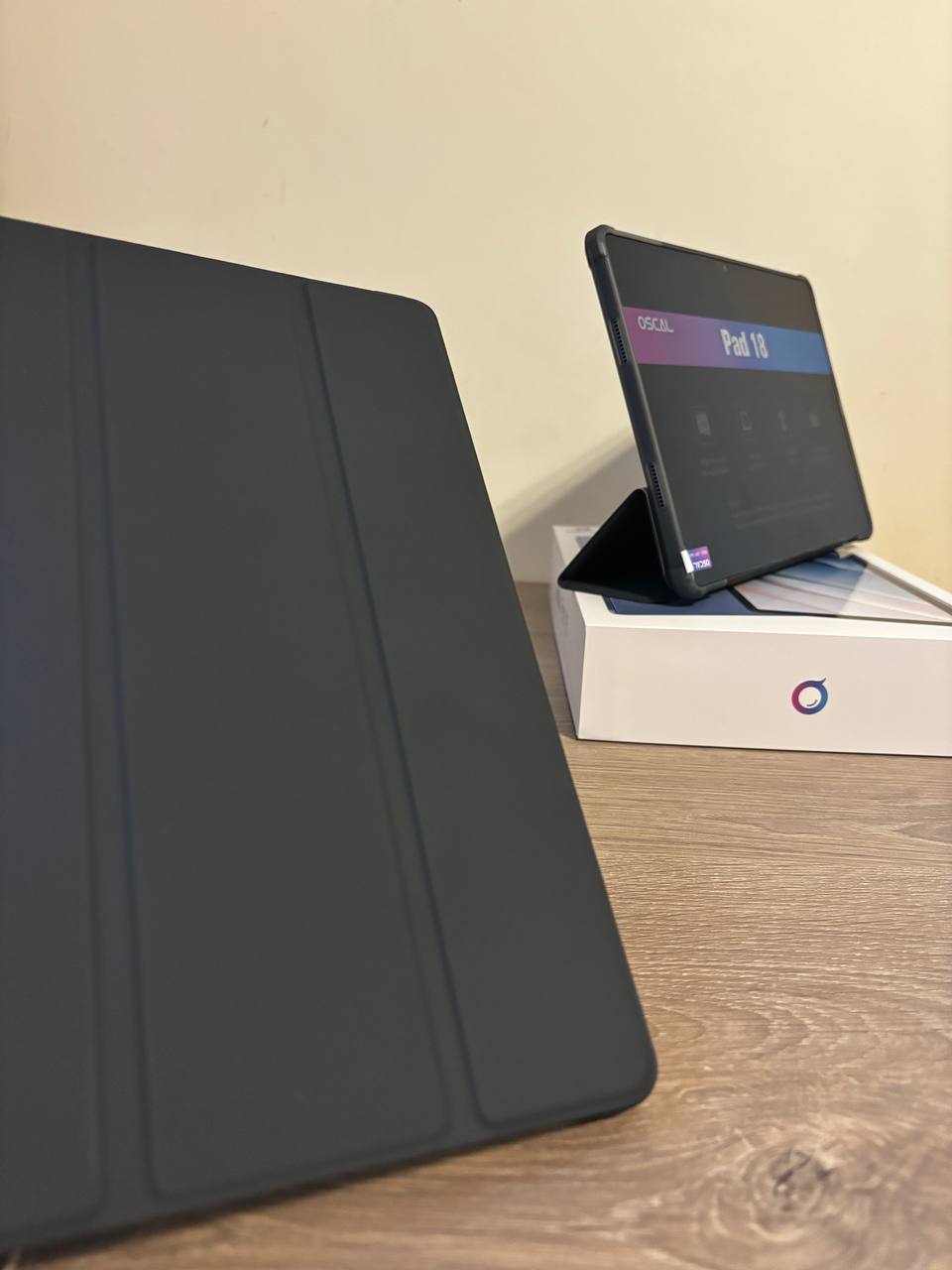
Another nice addition is the stylus included in the package. It has a rather interesting form factor – at the end, there is a plastic contact pad that responds to changes in tilt angle and pressure on the display. Will such a design be practical? We’ll find out during direct testing.

Read also: Redmi Note 13 Pro+ 5G Review: True Flagship
Design, materials, and build quality
In this section, we will begin to identify the main differences between Oscal Pad 16 and Oscal Pad 18.
Oscal Pad 16
Let’s start with the design and layout of elements in the Oscal Pad 16. The front side of the tablet is almost entirely occupied by the display, surrounded by a frame approximately 9 mm thick. In my opinion, this gives it a somewhat bulky look compared to the 10.5-inch diagonal display. The front camera is located in the center of the upper frame in landscape orientation.
The body is entirely metallic, gray in color, and made in a “unibody” format, meaning the back cover and side edges are a solid piece. In the center of the back of the body is the Oscal logo, with information about the manufacturer’s country below it in small font. Additionally, on this side of the tablet, there is a sticker with details about the Pad 16 model, which can be removed.

One of the main differences that the Oscal Pad 16 has is the configuration of the camera module. Visually, it looks very similar in both models, but in the Pad 16, there is only one functional module of the main camera, while the second one is added in the form of imitation. This is an interesting design element. We’ll talk about the Pad 18 camera later when we review it. Next to the camera, there is an LED notification indicator with bright yet soft and smooth illumination.
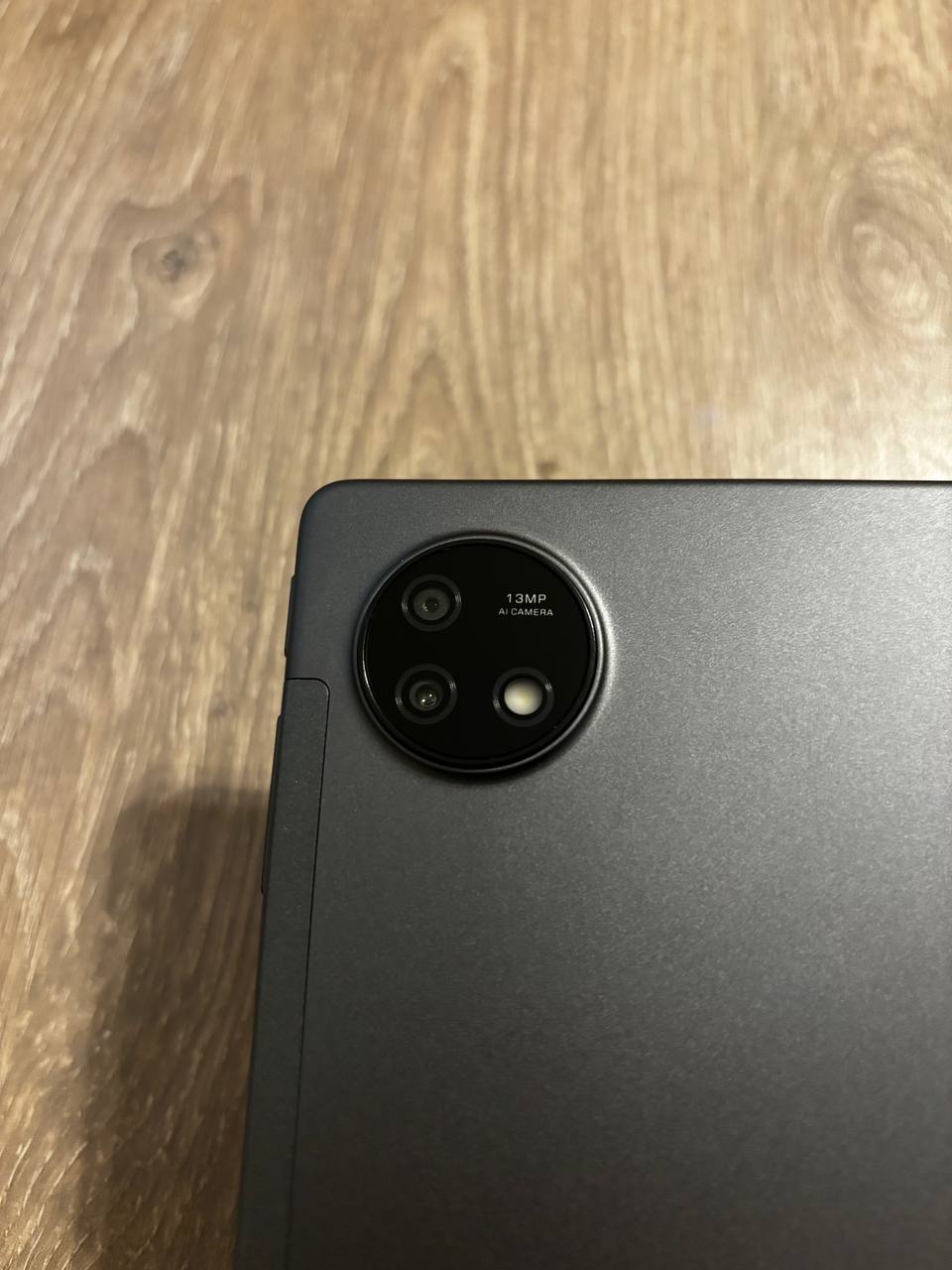
Let’s go through the side edges of the Oscal Pad 16. Along the entire perimeter, the edge of the body has a stamped recess on the back.
If you hold the tablet facing you in landscape orientation, at the bottom right corner is the headphone jack. On the bottom edge’s right side, there is a microphone. On the top end, in the left corner, the Oscal Pad 16 has the power button and volume control keys. The right side has a Type-C port with USB OTG support and a card tray. The tray is hybrid, allowing for either two nano SIM cards or one SIM and one microSD card. The microSD card might not be necessary as there is plenty of internal storage available. Additionally, there are two speakers on this side. On the left side, there are only two speakers. The Oscal Pad 16 does not have a fingerprint scanner but features face unlock functionality.
Summing up, I can say that the tablet looks stylish and has a compact size. However, the bezels are quite noticeable. All control elements have a classic layout. The presence of a simulated camera lens is a bit surprising, but the absence of unnecessary labels below the buttons is pleasing. The square edges give the tablet a modern look.
Oscal Pad 18
Let’s look at the layout and design of Pad 18 and compare it to Pad 16.
The Oscal Pad 18 stands out in terms of size. At first glance, the difference between 10.5″ and 11″ may not seem significant, but when you hold both in your hands, the difference is immediately noticeable. The display is surrounded by the same black bezel of 9 mm as in the Oscal Pad 16. However, it feels lighter and less noticeable. It gives off signs of the larger diagonal of the Pad 18.
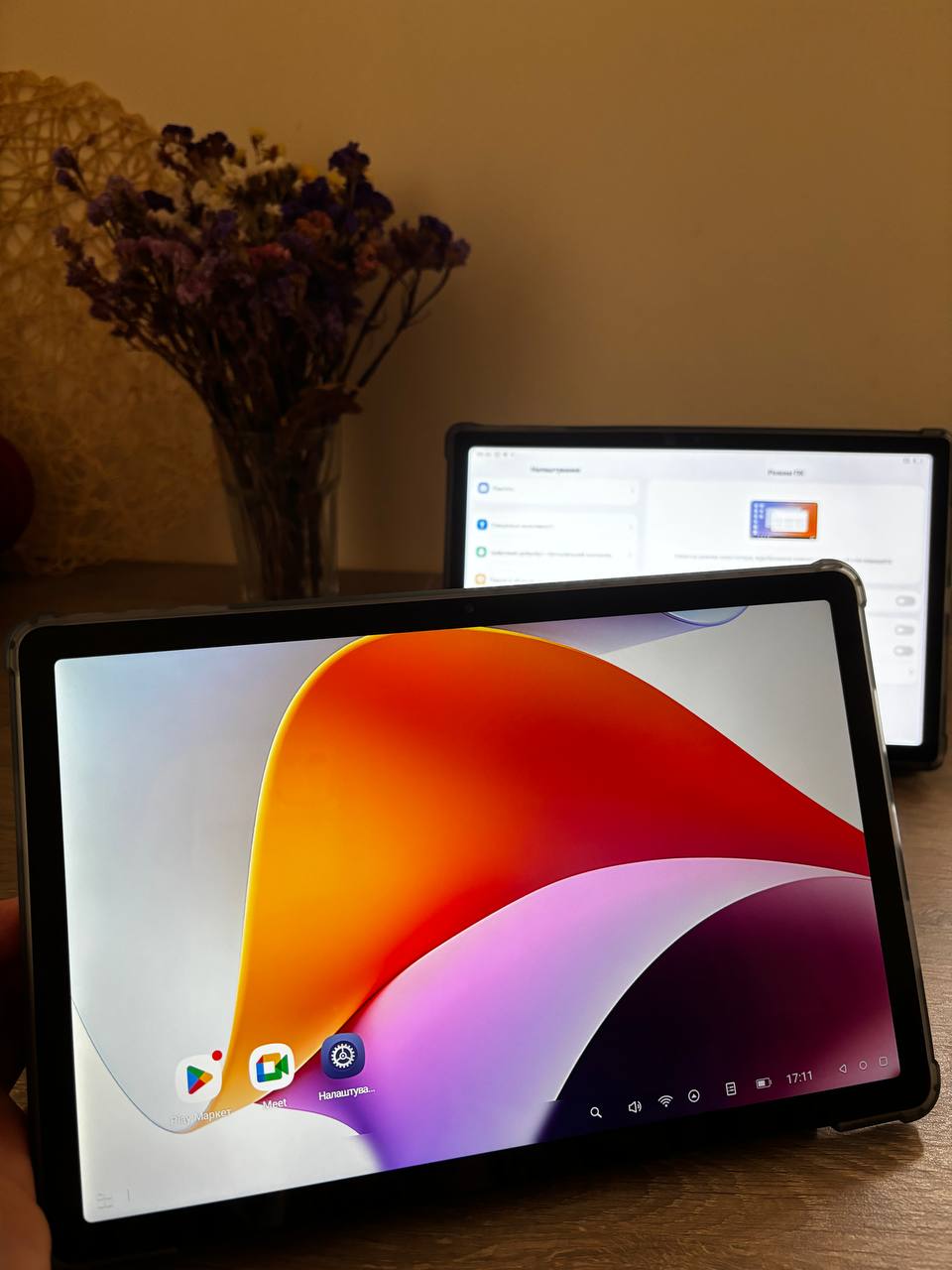
The tablet’s body is also metallic with flat edges, similar to the Oscal Pad 16. The placement of elements on the front and back sides of the tablet is the same as the Pad 16.
The side edges feature the same elements as in the Oscal Pad 16: a Type-C port, a card tray, and a 3.5mm jack, along with 4 speakers and a microphone. The tray for SIM cards is also combined in the same manner.
The camera module in the Pad 18 looks almost the same as in its predecessor, with just one difference – it features a dual 13 MP + 2 MP camera setup. Both modules are functional. I must note that I prefer the design of the camera module in the Oscal Pad 18; it feels like there has been more attention to refining the style. The rim around the module is covered with notches, resembling those found on a camera lens. The LED flash is quite large.
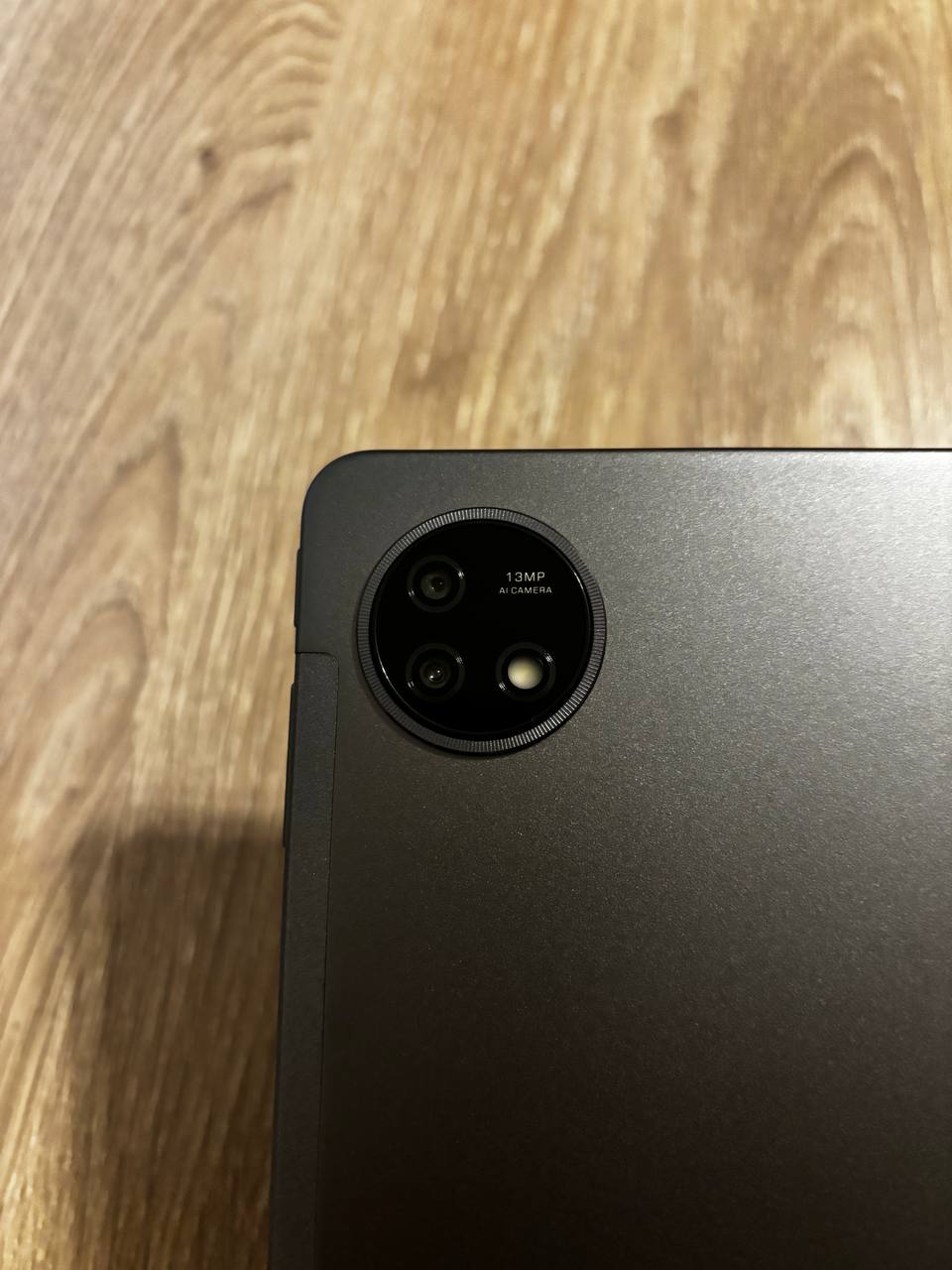
In general, both the Oscal Pad 16 and Pad 18 have a similar stylish design and layout of elements. The advantages of the Pad 18 lie in its larger diagonal and less noticeable bezels. It is lighter, making it more comfortable to hold. However, the Pad 16 is more compact, which may be a significant criterion for some users.

Read also: Review of Lenovo Legion Glasses: glasses – a pocket monitor for gaming and more
Display
In reality, for the budget tablet Oscal Pad 16, a 10.5″ diagonal is already perceived as optimal. With its resolution of 1920×1200, you can expect comfortable viewing.
Since there is no automatic brightness adjustment, users will have to adjust it manually. In the display settings, there are 3 image profiles. I’ll focus on the “Professional” profile, which allows manual adjustment of the color temperature. Speaking of the minimum and maximum allowable brightness of white, a maximum of 400 cd/m² is sufficient for outdoor work, while a minimum of 8.15 cd/m² is enough for viewing images in complete darkness. From my own experience during the outdoor test, I noticed that the Pad 16 display has excellent anti-glare characteristics.

The maximum polling frequency of the sensor is 120 Hz, and the contrast ratio is 1465:1. Among the drawbacks, I note the low display refresh rate – only 60 Hz, and the lack of HDR support.
The manufacturer points out improvements in video playback on YouTube, and I am indeed pleased with what I’ve seen. Additionally, the Pad 16, like the Pad 18, features a PC mode. In my opinion, this is more practical and engaging for a tablet with a larger screen. However, even for the model with a smaller diagonal, this function will be an advantage compared to competitors.
 The PC mode visually resembles the Windows desktop mode. Thanks to it, the tablet can be instantly transformed into a laptop by connecting a wireless keyboard and mouse. You can also interact with the touchscreen display and use a stylus. There’s a split-screen function available. The button to access the list of all installed programs moves to the bottom left corner, similar to the “Start” menu button. The mode is convenient, although not all software is supported, which users will be notified of immediately. Also, it’s worth noting that in PC mode, you can use any Bluetooth keyboard, but it’s better to use the original one from the manufacturer, as it is relatively inexpensive and lightweight.
The PC mode visually resembles the Windows desktop mode. Thanks to it, the tablet can be instantly transformed into a laptop by connecting a wireless keyboard and mouse. You can also interact with the touchscreen display and use a stylus. There’s a split-screen function available. The button to access the list of all installed programs moves to the bottom left corner, similar to the “Start” menu button. The mode is convenient, although not all software is supported, which users will be notified of immediately. Also, it’s worth noting that in PC mode, you can use any Bluetooth keyboard, but it’s better to use the original one from the manufacturer, as it is relatively inexpensive and lightweight.
The Oscal Pad 18, in turn, features an IPS display with a resolution of 1920×1200. Additionally, the tablet has a Widevine L1 certificate, which supports streaming content with resolutions up to 1080p on platforms such as Disney+, Hulu, Amazon Prime Video, and others. By the way, the Pad 16 also supports this technology. I noticed that the built-in YouTube app cannot play videos higher than 1080p60. However, Full HD mode playback is smooth. The tablet does not overheat when operating at maximum quality settings.
In the Pad 18, as in the Pad 16, several display modes are provided:
- Reading mode for e-books similar to Kindle
- Night Light mode to reduce eye strain during nighttime viewing
- Multi-level dark mode for different lighting conditions.

Thus, for a reasonable price, we get something intermediate between a tablet and a laptop. The Oscal Pad 18 has larger dimensions, but it hasn’t made it bulky; it’s still adapted for mobile use, just like the Pad 16. The PC mode is optimized in both Oscal models. Therefore, if having a compact tablet is crucial for you, I recommend paying attention to the Pad 16. However, if you prioritize greater autonomy and improved video viewing, then the Oscal Pad 18 is the way to go.
Read also: Cubot Tab Kingkong rugged tablet review
Performance
Oscal Pad 16
The Oscal Pad 16 operates on the Unisoc T606 chipset. The test model has 256 GB of internal storage, but there is also a version with a smaller capacity of 128 GB. It comes with 8 GB of LPDDR4x RAM with the ability for virtual expansion up to an additional 8 GB, totaling 16 GB. If needed, you can also add a microSD card with a capacity of up to 1 TB.
Let’s conduct testing to gain a better understanding of the capabilities of the Oscal Pad 16:

As I previously mentioned, the tablet’s body hardly heats up. I also didn’t notice any decrease in performance after prolonged use of the Pad 16.
The gaming mode is available on the tablet, although it has a limited set of functions. It automatically blocks incoming notifications and calls to ensure better immersion in the gaming process and optimizes system resources to provide maximum performance and minimize lag during gameplay. So, although the device isn’t specifically designed for gaming, it can easily handle casual gaming without any issues.

The Oscal Pad 16 runs on Android 13 with the Doke OS_P 3.0 interface. It comes with pre-installed software from Google as well as from the manufacturer. The tablet is equipped with two sensors – an accelerometer and a pedometer.
Oscal Pad 18
The Oscal Pad 18 is equipped with a powerful octa-core processor, the Unisoc T616. The tablet comes with either 8 or 12 GB of RAM. This capacity can also be expanded if needed. As mentioned earlier, the test model has 256 GB of internal storage, which can be further expanded using a microSD card with a capacity of up to 1 TB.
To further familiarize yourself with the capabilities of the tablet, tests will help:

The 8-core Unisoc T616 processor ensures smooth operation of the Oscal Pad 18 when using multitasking applications and games, providing high performance under any conditions. Pad 18 didn’t become significantly more powerful than its older sibling, but simple arcade games for relaxation will work great on it.
The conclusion about the performance of both tablets can be roughly similar since their capabilities are alike. Oscal Pad 16 and Pad 18 don’t overheat under load, have sufficient memory capacity, and provide very pleasant sound. Both have a convenient PC mode for multitasking. Perhaps Oscal Pad 18 will handle heavy games slightly better, although it’s worth remembering that they are not gaming devices after all.
Battery life
Oscal Pad 16 boasts a good battery life thanks to its 8200 mAh capacity battery. Even with a SIM card installed and receiving calls, I didn’t encounter any issues with battery longevity. Connecting to Wi-Fi also didn’t significantly impact the device’s discharge rate. In standby mode, Pad 16 discharges gradually without any notable acceleration.
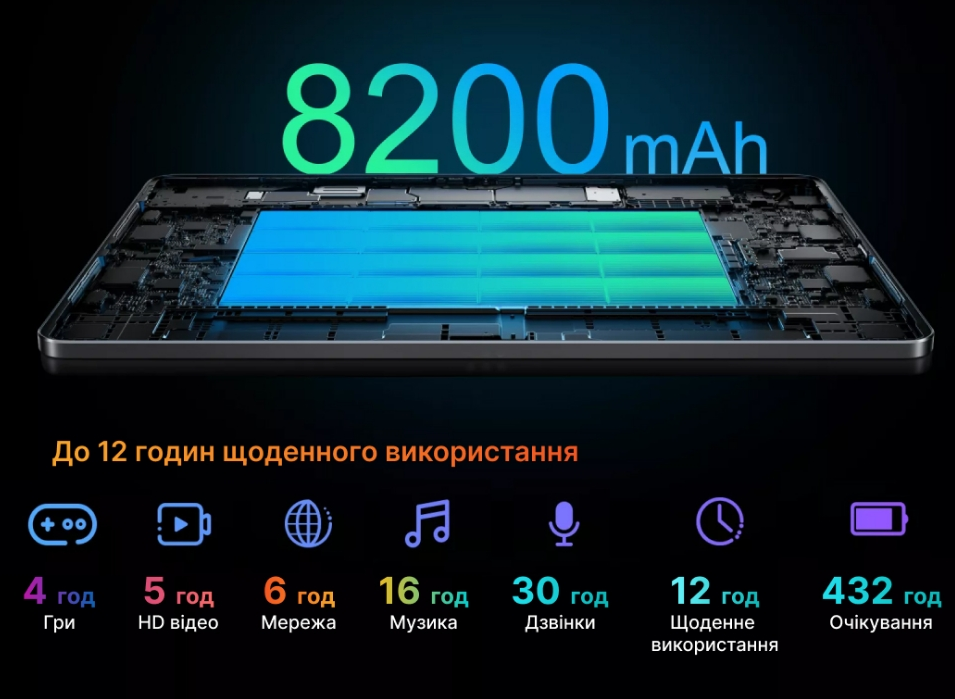
In summary, we have 5 hours of video playback, 6 hours of web browsing, 4 hours of gaming, 16 hours of music playback, 30 hours of call time, and 432 hours of standby time. It took 3 hours to fully charge from the included adapter, which I consider to be an average figure for this type of device.
Thanks to its 8800mAh battery capacity and 18W fast charging, the Oscal Pad 18 offers up to 10 hours of active usage. This means you can count on a full day of work outside your home without worrying about recharging. The manufacturer promises 5 hours of continuous video playback, 4.5 hours of gaming, 7 hours of web browsing, 15 hours of music playback, 37 hours of call time, and 432 hours of standby time.

Summing up, it’s worth noting that the Oscal Pad 18 has a larger battery capacity and longer battery life compared to the Pad 16. Both tablets exhibit gradual battery drain under load, without significant fluctuations.
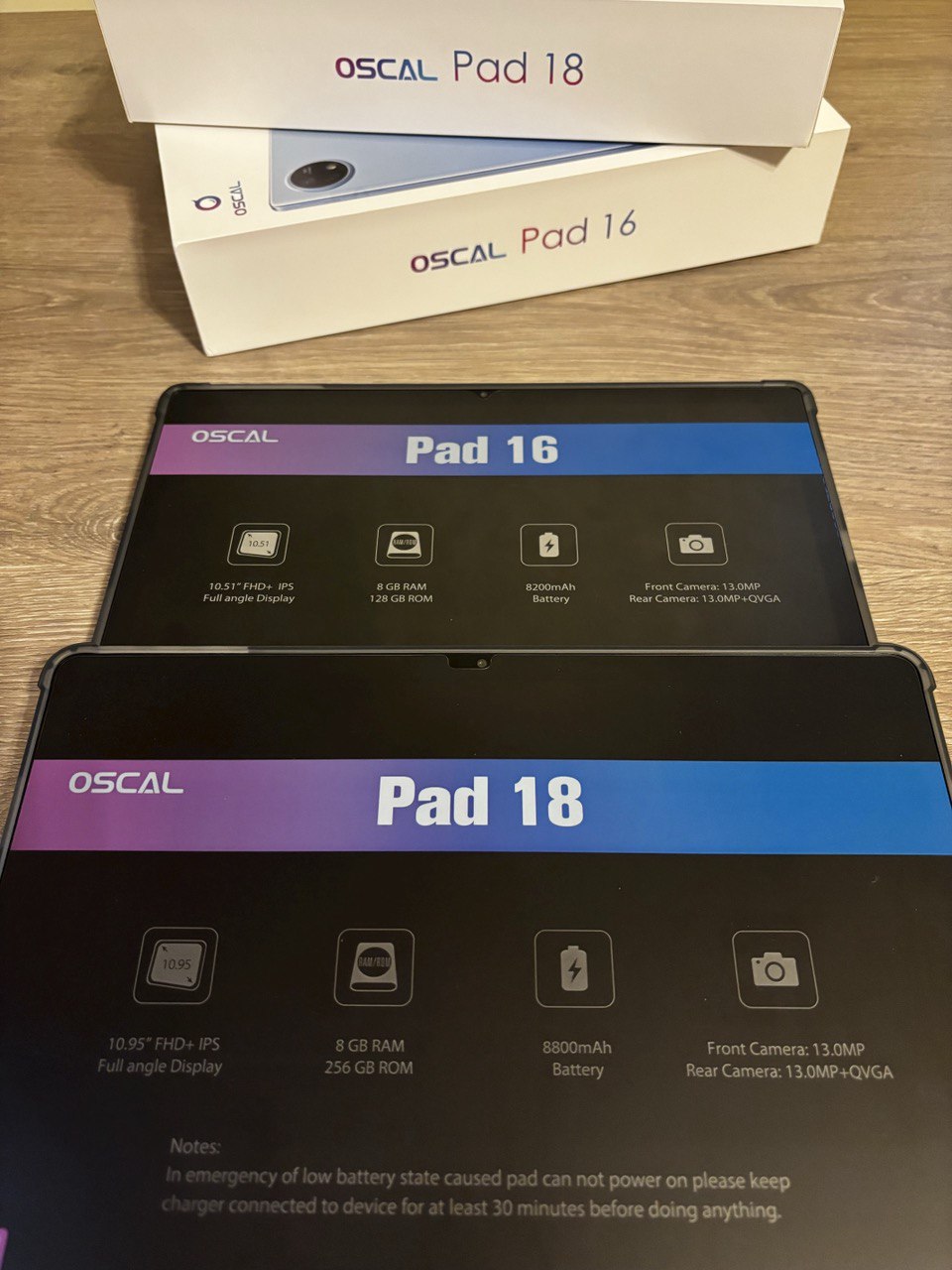
Cameras
Oscal Pad 16
The Oscal Pad 16 is equipped with a 13 MP main camera. It’s suitable for capturing nice photos and videos with adequate detail and clarity. With Google Lens integration, the Pad 16 offers users the ability to quickly search, recognize text, and translate, making tablet usage even more useful. Recording video in Full HD resolution allows for creating quality content even with a tablet.
The camera features autofocus and a flash, allowing you to capture photos with fairly good detail, which is rare for a budget tablet. It also includes a self-timer and 4x digital zoom feature.
When shooting with the front camera, you can only zoom in on the subject in the photo using the “pinch” gesture. Mirror reflection can be applied in the settings.

Video recording with the main camera is captured in 1080p at 30 frames per second, while with the front camera, it is only in 720p. The autofocus works well on the main camera, but this function is not available on the front camera.
Oscal Pad 18
When it comes to the cameras of the Oscal Pad 18, it’s hard to add much more. Although the Pad 18 features a dual main camera setup of 13 + 2 MP from Samsung, which provides high-quality images, the photos taken on the Pad 16 are equally impressive. I suggest comparing real images to see the difference.
Photos taken on the street:
Photos on the front camera:
 Just like in the Pad 16, in the Pad 18, we have the same integration of Google Lens, enabling quick searches, text recognition, and translation. The Full HD video recording feature allows for high-quality video capture. Here is an example video:
Just like in the Pad 16, in the Pad 18, we have the same integration of Google Lens, enabling quick searches, text recognition, and translation. The Full HD video recording feature allows for high-quality video capture. Here is an example video:
As for me, both tablets have quite decent, if not good, cameras for this device segment. Of course, I wouldn’t compare photos from a tablet to those from a smartphone, but the cameras in these tablets are pleasing.
Photos taken indoors:
Indeed, such photos and videos can definitely be used for work, and even posted on social media.
Read also: Cubot Tab 40 review: budget tablet for undemanding users
Communications
Both tablets support LTE and can work with two SIM cards, allowing for phone calls. However, they lack call recording functionality. The tablets are also equipped with Bluetooth, which operates only with the SBC codec.
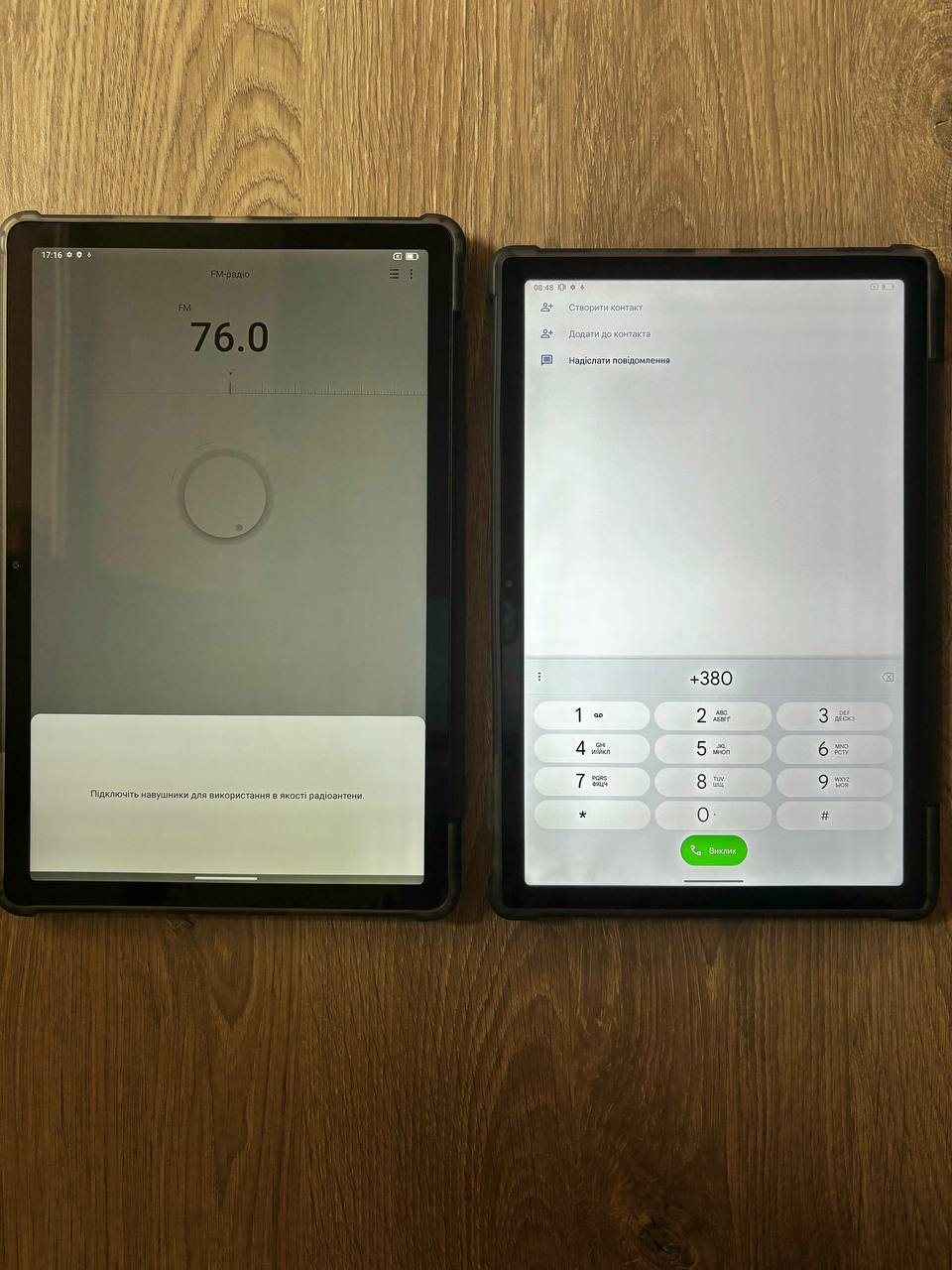
As GPS navigators, both the Pad 18 and Pad 16, in my experience, are not ideal. The number of satellites found is not the highest, and their detection speed is low, especially indoors (by the way, the Pad 18 found satellites much faster and detected more of them). However, it’s worth remembering the concept of a “cold start.” Moreover, determining the position with just four satellites is sufficient. However, serious issues with location determination did not arise outdoors. Electronic compass support is not available. Therefore, I wouldn’t consider the tablet as a navigation device. For travel, I would take the tablet more for entertainment, and I would use the phone for navigation, as it is better suited for this purpose.
Sound
I was pleasantly surprised by the sound on both tablets. They are both equipped with the Quad Smart-K Box system, which provides decent acoustic quality with crisp highs and deep bass. The presence of four speakers creates a rich and immersive 3D sound, giving a sense of presence. I want to emphasize the well-thought-out placement of the speakers on both sides of the tablets, both at the top and bottom. This minimizes the chances of accidentally covering them while using the devices.
The Oscal Pad 16 and Pad 18 are excellent choices for use as a portable cinema, as they provide quality visuals with great sound. When playing music at maximum volume, I was satisfied with both tablets.
Conclusions
The Oscal Pad 16 and Oscal Pad 18 are quite intriguing, from their design to their technical capabilities. At first glance, the difference between them lies in the screen size diagonal and weight, with Pad 18 being lighter despite having a larger display. The technical specifications are not significantly different, but slightly better in the Oscal Pad 18. This primarily applies to the battery capacity and additional features.
The Pad 16 and Pad 18 deliver great sound and are suitable for casual gaming, but the Pad 18 will be able to handle slightly heavier games. It’s important to remember that these are not gaming devices per se. Rather, they serve as an ideal option for a portable cinema experience, offering excellent image and sound quality.
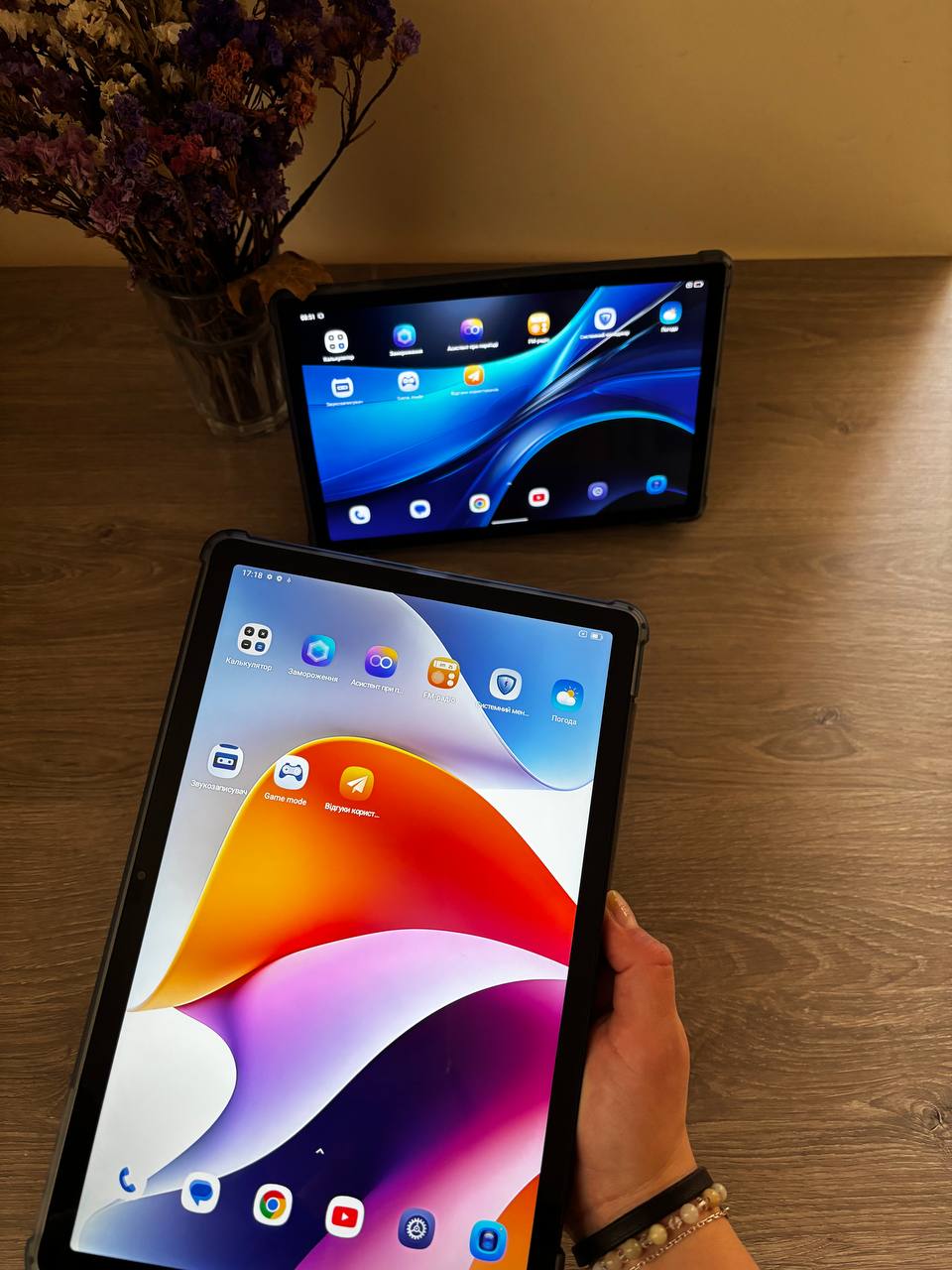
Both tablets offer several reading modes for comfortable reading. If you’re considering a tablet as an additional e-reader, then I would recommend the smaller Oscal Pad 16.
As for the cameras on both tablets, they deserve special praise. I haven’t seen tablet cameras that could compete in quality with budget smartphones in a long time. The same goes for the video, which you can confidently share on social media. It’s hard for me to pick one tablet in this regard.
I also want to point out the ability to work in PC mode, supported by both devices. For convenience, they come with a stylus and have the option to connect a keyboard. The stylus has an interesting and unusual configuration. However, as my experience has shown, it adds convenience during long work sessions and also protects the display from unwanted scratches.
The price of the tablets is acceptable and does not differ much, so both have the potential to become your assistant and entertainment in everyday life.
Read alsо:
- ASUS ROG Strix Scope II and Strix Scope II RX: Review and Comparison
- Realme 12 Pro Plus 5G Review: Created for Success


